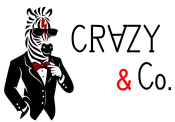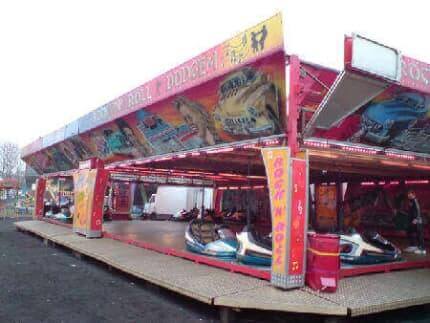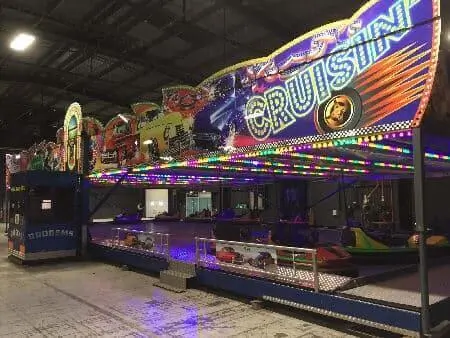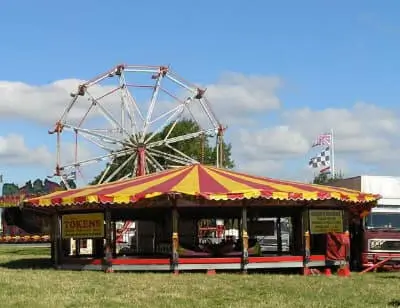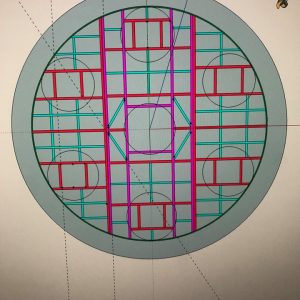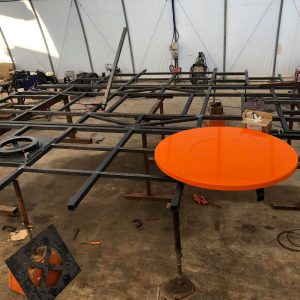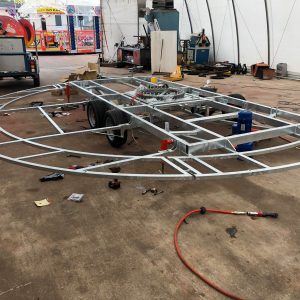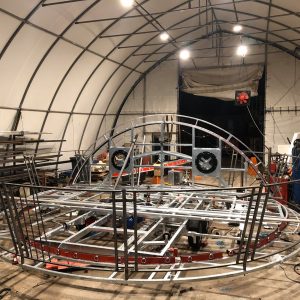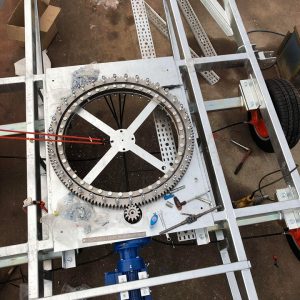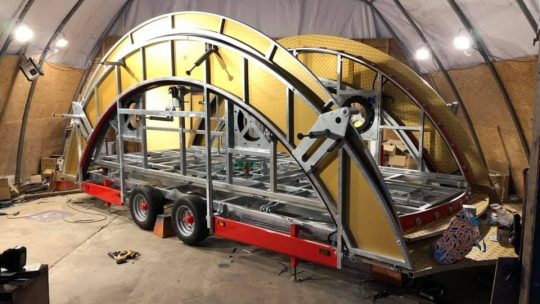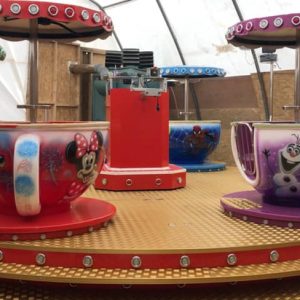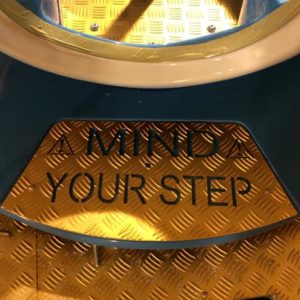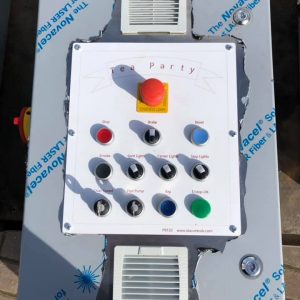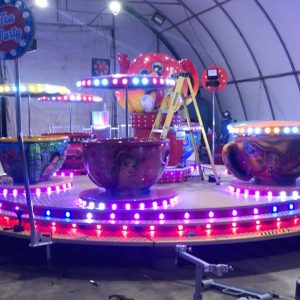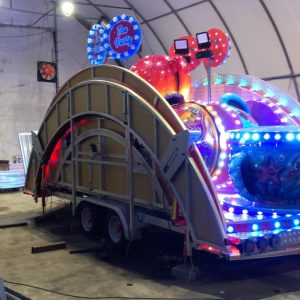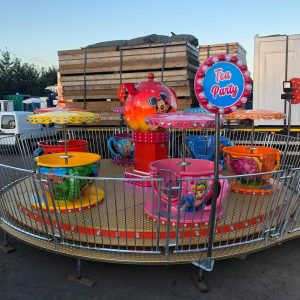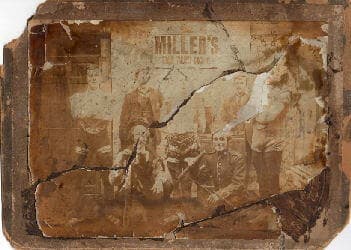The mainstay of the modern fairground are the thrill rides. Higher, faster, more daring, with bright lights and loud music. But if we harken back to a simpler time, the main attractions were the shows. Wild West displays of shooting prowess, giants, strange animals, boxing booths. In the pre television and internet days, many peoples first glimpse of cinema was at a fairground. The trade organisation the Showmen’s Guild used to have a rule that a certain percentage of a fairground had to be reserved for sideshows. In my native North East, the popular local term for a funfair is ‘The Shows’.
Wild West
Some of the most popular were the Wild West shows, trick lassoo work, even fancier shooting, with live bullets, none of this modern day cork shooting nonsense. Though the fairground industry still has an exemption from firearms certificates for guns upto 0.23 calibre. And there is at least one example of a live round shooting gallery that I know of attending funfairs.
This was one of the most popular, in part due to the lady doing the shooting. Florence was not only talented but glamorous to boot. I knew her into her advanced years and at 70 she was still a stunning woman. Her son married my Mothers sister so we are family.
George The Gentle Giant
Another family connection with this one. An uncle from Scotland had found George and gave him a job in this show. George was one of the nicest men you could ever meet. I remember being a kid and at that age he looked like a true giant out of the books. He always had a smile and would say hello, but in his broad accent I could never understand a bloody word he said, so I would just nod. The picture of George shaking a ladies hand was one of the souvenirs you could buy from the show and George would sign it. The lady pictured is my mother. One set of photos actually had George stood holding a kid on each arm, I was one of the kids, but I can’t find a photo at the minute.
Boxing Booth
Another long time favourite in the old days was the boxing booth. One of the best loved was Ron Taylors. I can remember Ron, a really small guy who was lovely. Ron’s family had started a bare knuckle boxing booth in Wales in 1861. Only providing their competitors with gloves when it became compulsory in the 1930’s.
At the peak of the popularity there were around 100 boxing booths in the UK. I think Taylors was the last of them. He would recruit professional boxers as his champions, and if a local lad could last 3 rounds with him, he would receive a cash prize. Few remained on their feet to collect.
Ron once had the great Mohammed Ali give an exhibition performance for charity. The two became friends and the Champ invited Ron to his wedding blessing.
At Durham Miners Gala one year, where they was always a rough bunch, a drunken miner staggered up the steps of the booth and headbutted the large brass bell that Ron used to ring to attract attention. Trouble was said brass bell had a razor sharp edge. There was blood everywhere, they took him away in an ambulance.
Freak Animals Show
Probably something that wouldn’t get past the PC brigade now, but popular in its day. The animals tended to be things like double headed sheep, and snakes with two tails. All rather freakish, oh, and as a rule all rather dead.
One exception to the rather dead rule was on Gilbert Chadwick’s animal show. He actually had a live monkey as one of the exhibits. Joey the monkey was some small breed about the size of a cat. He was lightning fast and had really sharp teeth. This I can attest to, as a young kid, a group of us were with one of the older boys feeding dead goldfish to Joey. Unfortunately I didn’t let go of mine quickly enough and Joey bit me.
Colin, the older kid gave me a bottle of shandy as a bribe not to tell my dad. But when they saw the blood and demanded to know what happened I caved in and spilled the beans.
Now, to take your kid into hospital with a monkey bite, would be an unusual occurrence for any doctor. What made it worse, was the fact that this all occurred in the town of Hartlepool.
For those who don’t know, there was a French warship wrecked off the coast of Hartlepool during one of our many conflicts with France. Legend has it the only survivor was a large monkey who was the ships mascot.
The locals having never met a Frenchman, and being a bit dim, assumed the monkey was a French spy. They tried questioning him, but as none of them could speak French, and the monkey wasn’t too good with English, they decided to hang him for not cooperating. Hence the nickname for the locals of monkey hangers.
So, in we traipse to hospital and the doctor asks whats up.
“My son has been bitten!” says dad.
“No probs”, says the doctor, “What has bitten him?”
“A monkey”, replies dad, cheerily
“Ha Ha Mr Moody, we have heard all the jokes before, whats really bitten him?”
Now when dad again reiterated it was a monkey the doctor wasn’t amused. After a brief explanation though we got him to believe us, he ended up ringing a specialist unit in London to ask how to treat a monkey bite. Turns out the same as a dog bite, clean the wound and a Tetanus injection.
Striptease Show
Again, before the rise of the PC movement, there were a number of strip shows at funfairs. My wife’s Great Uncles owned one, which we used to see at the Newcastle Town Moor every year. To give them their due, they wouldn’t let us kids in, well, not unless we were accompanied by an older kid.
But we spent a couple of hours every morning in there attending some preacher giving religious education lessons. I am not sure how the heck our parents actually got us in there initially, but the preacher was quite astute. If you listened to your lessons and answered questions correctly he would give you a ticket. A certain amount of tickets would win you a bible. Suddenly it became a competition. We didn’t really want the bibles, but we did want to be top dog.
Those Great Uncle’s were the Gooch Brothers, George and Lonzo. Legends in the North East. Their ingenuity knew no bounds. One year at Durham Miners gala. The star of their show ran off at teatime. With no hope of finding a replacement they appeared stuck. The solution was elegent in its simplicity. They quickly painted a board for the front of the show with ‘Durham Sky At Night’ Emblazoned across it. When you paid you shilling to go in, you would find that they had removed the roof of the show, allowing you to gaze up at, yup, Durham’s sky at night.
A similar crises befell them at another event, and their crazy inventiveness saved the day again. Another hastily painted sign proclaimed ‘See the Holy Water Otter.’ When you forked you money over and entered the bowels of the show, there, sat on a table, in a cage, was a Kettle punched full of holes. ‘Holey water Hotter’ get it. Thankfully the patrons tended to see the funny side, as they seldom had to argue over the no refunds sign.
Their mother, was well known as the tattooed lady. During a particularly grim economic period, she was struggling to make ends meet. To remedy this, she had her entire body, save for her head hands and neck, completely covered in tattoos so she became a sideshows exhibit. Imagine the pain that must have been. I think they were of a lot sterner stuff in those days.
Other SideShows
I have only touched on the multitude of sideshows that once travelled the length and breadth of the country. Few of them would still be viable now. Some, like the strip shows wouldn’t be allowed. And others like the freak animals, well, you can look at that stuff all day long on the internet.
I especially like the cat in the last picture, I presume it is searching for some of the former stars of the sideshows.
